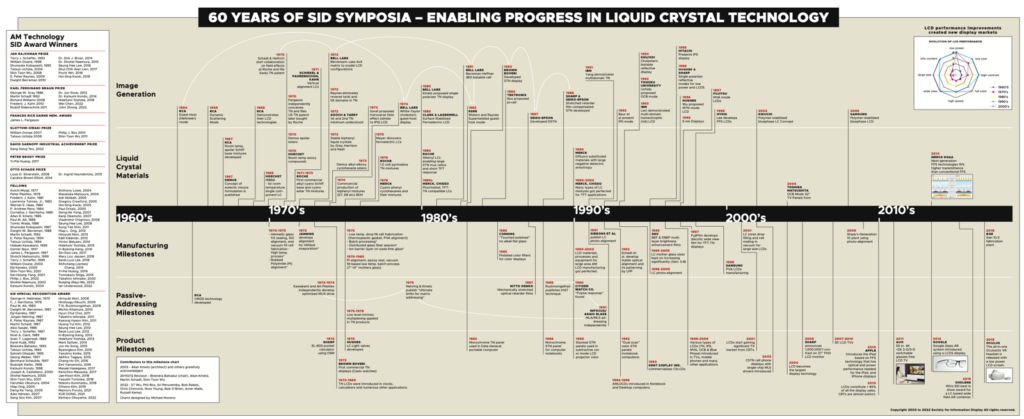At Display Week in 2012 and 2022, SID showed some very extended timelines (50 and 60 years, respectively) of display technologies, highlighting how many companies and organisations have been involved in getting us where we are today. Recently, I was included, as an observer of the industry, in a request to see if there were new developments in the LCD field that justified inclusion in the chart. The only one I could think of was the development of ‘IPS Black’ displays by LG Display.

In the early days of LCDs, the viewing angle performance was terrible. Although scientists had developed active matrix TN technology to get over the slow response time of STN displays, the performance varied dramatically when the display was viewed from different angles, particularly when viewed from below.
I remember someone ( I think it was Sharp, but can’t be sure) that highlighted the poor viewing angle of some LCDs by demonstrating some TVs laid flat at a trade show. While viewers were not going to get down on their knees to see the ‘view from below’, the difference was very evident when the displays were laid flat.
IPS Has Been Around for Three Decades
Anyway, the first firm to commercialise a solution to the viewing angle challenge was Hitachi in 1995 when it introduced an IPS monitor. I still have one of those monitors in my loft somewhere, as for years I ran training courses for monitor marketing people and having a range of early monitors made it easier to see the imperfections. The impact of the IPS technology was profound on the monitor business as it really gave a very wide viewing cone with low colour shift. I often would say that it really should be the duty of all monitors to look the same whichever angle you were looking from, but that has only really been the case with IPS! IPS has come to dominate the monitor market.
A couple of years later, Fujitsu introduced the VA concept and that led to a range of different variations. VA was much better than TN in viewing angle, had better speed than IPS and had much higher contrast if you were looking ‘on axis’. TV went on to become dominated by VA LCD technologies which have continually improved. No buyers of big brand TVs with VA panels these days should be complaining of poor image quality, in viewing angle or contrast. However, colour shifts at different viewing angles are still not as good as IPS.
A variation of IPS was developed, called FFS (for Fringe-field switching) that attracted only a little attention, until Apple adopted it as it gave better performance than IPS. Panels that are described in specifications as ‘IPS’ are not infrequently actually based on FFS in reality.
IPS struggled to get black levels down low enough to a level that would deliver more than around 1,000:1 contrast although some makers pushed that to 1,500:1. That was still a long way from the 3,000:1 and more of VA panels.
Then LG Display announced ‘IPS Black’, a new technology that boosted IPS up to 2,000:1 contrast. However, unusually, the firm wouldn’t say how it was doing it. That was particularly surprising as in general, firms like to brag about their technology.
Dell seems to have been particularly associated with the IPS Black panels and has a number of models available using it, including a 4K 32″ that would fit nicely on my desk and a 6K that should be released soon that I would love to try. (both broad hints to Dell PR!). Again, somewhat surprisingly, LG Electronics’ monitor business doesn’t seem to be interested in IPS Black. I couldn’t see any monitors with that technology on the LGE website locally when writing this article.
IPS Black or OLED?
I have a very good, but now ageing 32″ VA-based monitor and when it comes to replacing it, eventually, it’s going to be a hard decision for me between the best of the IPS panels and an OLED. I love the image quality of OLEDs, but I would still be a bit nervous about the burn-in on a monitor, given the ridiculous amount of time I spend behind mine!
At Display Week in 2023, Merck and BOE both presented papers on significant improvements in contrast for FFS LCDs. I speculated then that the development of LG’s IPS Black might be related to the new ‘licristal XtraBright UB-FFS’ LC material developed by Merck that I talked about in that article.

It has since been confirmed by industry sources that my speculation was correct and that Merck and LG Display collaborated on the development of IPS Black. As well as changing the liquid crystal material itself, a significant change has been a move from a ‘normally off’ mode to ‘normally on’. In other words, traditional IPS showed a black pixel when no drive voltage was applied, while with IPS Black, no drive voltage means a white pixel. That will mean that damaged panels with driver or bonding failures will show white streaks on the display, rather than the black symptoms that have traditionally been seen on damaged panels.
The use of negative mode panels and the new material means response times are not yet as good as the positive mode panels, so IPS Black is not yet suitable for gamers, but no doubt LGD, BOE, Merck and others are working on how to fix that issue.
Bob Raikes is semi-retired from the display industry, but still edits the 8K Association newsletter and contributes to Display Daily. He plans to be at Display Week for Display Daily and others.

